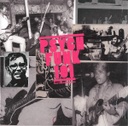TRACKLIST
A1. Husnu Ozkartal Orkestrasi: Su Derenin Sulari
A2. Kukumbas: Respect
A3. Mulatu Astatke feat. Belaynesh Wubante And Assegedetch Asfaw: Alemiye
A4. Kim Sun: The Man Who Must Leave
B1. Petalouda: What You Can Do In Your Life
B2. Mehr Pooya: Doe Pajereh / Ghabilehe Leili
B3. Staff Carpenborg And The Electric Corona: All Men Shall Be Brothers Of Ludwig
B4. The Group: The Feed-back
C1. Armando Sciascia: Circuito Chiuso
C2. Wadih Essafi: Aandak Baharia Ya Rayess
C3. Omar Khorshid: Rakset El Fadaa
D1. Metin H. Alatli: Mevlana Boyle Dede
D2. George Garanian With The Melodiya Jazz Ensemble: The Big Search
D3. Eskaton: Dagon
DESCRIPTION
Funky fuzzy psychedelic tracks from 60s and 70s Nigeria, Iran, Turkey, Russia, South Korean and other exotic countries
Rare and previously unreleased tracks restored and remastered, many from the original master tapes!
Psych-Funk 101 introduces students to the global phenomenon of psychedelic funk music, and covers the “golden years” of the movement, from approximately 1967 until 1980. This compilation does not focus on American and British bands. Rather it focuses on the bands throughout the Global Village that were influenced by the innovation of American and British bands – that many times one upped the heroes they sought to emulate. This compilation focuses on bands influenced by James Brown, The Meters, Sly and The Family Stone, Booker T and The MGs and The Bar Kays and unsung rhythmic forces such as drummers Bernard Purdie, Idris Muhammad, Earl Palmer, bassists such Carol Kaye and Jimmy Lewis. It focuses on bands who took that energy and combined it with the flair of psychedelic-rock musicians such as Jimi Hendrix and the ensemble known as Cream – as well as pop-rock acts taken by the experimental side of psychedelia such as The Beatles. But these bands added their own, unique cultural flourishes. The result is mind-bending.
Think about it for a second – what musical forces were greater than that of funk and psychedelic music in the late 60s and early 70s? These forces, combined by bands happy to incorporate folk music and improvisational elements from other musical forms, lead to an amazing body of work still being unearthed by researchers the world over – and still capable of inspiring new investigations into shapes of rhythm.







